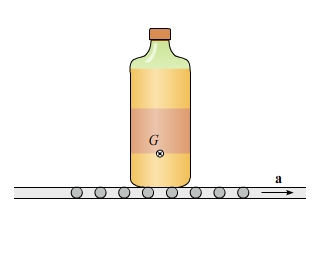Learning Goal:
To apply the kinetic equations of motion to rigid bodies undergoing translation.
When a rigid body undergoes translation, each particle of the body has the same acceleration aG=a , where aG is the acceleration of the center of mass. Also, the rotational equation of motion reduces to ∑MG=0 .
The scalar equations of motion for rectilinear translation, where all
particles travel in parallel straight-line paths, become
∑Fx=m(aG)x
∑Fy=m(aG)y
∑MG=0
where ∑Fx and ∑Fy are the sum of the forces in the x and y directions, respectively, m is the mass, and ∑MG
is the sum of the moments about the center of gravity. The scalar
equations of motion for curvilinear translation, where all particles
travel in parallel curved paths, become
∑Fn=m(aG)n
∑Ft=m(aG)t
∑MG=0
where the subscripts n and t denote the normal and tangential
directions of motion, respectively. The moment equation for both types
of translation, ∑MG=0 , can be replaced by a summation of moments about an arbitrary point A, where the moment of maG must be accounted for with the following equation:
∑MA=∑(Mk)A
where the term ∑(Mk)A is the moment of maG about point A.

Part A
The bottle in the figure a = 7.30 ft/s2
|
|
0.227
|
Part B
The door in the figure has height c = 3.00 m , mass m = 9.10 kg , and center of gravity G, where b = 1.50 m and d = 1.50 m . (Figure 2) If the man exerts a force F = 10.6 N at h = 1.00 m off the ground, determine the amount of time, t , it takes the man to move the door a distance s = 3.70 m to the right. The door is initially at rest; the initial velocity and position are v0 = 0.000 m/s and s0 = 0.000 m , respectively.
|
|
2.52
|
|
Part C
Consider the same door shown in Part B. The distance of d = 1.50 m is the distance from the center of the door to the wheels at points A and B. Find Ay and By , the reaction forces at points A and B, respectively.
|
|
46.4,42.9
|
|
No comments:
Post a Comment